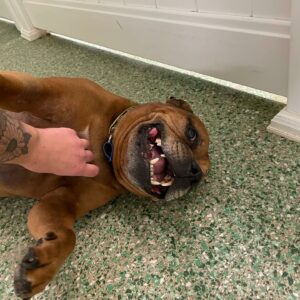Have you ever wondered if dogs are ticklish? We know that dogs love a good old itch and a belly scratch, but is that the same as being ticklish? Studies have shown that apparently, the answer is yes!
Like humans, dogs are sensitive when touched in certain areas and have the same nerve endings and sensations in their skin as we do. According to barkspot.com, scientists have coined two different terms referring to different kinds of tickles – ‘knismesis’ for light touches, and ‘gargalesis’ for heavier tickles. There is no evidence to date that dogs can experience gargalesis – this is a more intense kind of tickle that causes humans to break into fits of laughter when they are touched in sensitive areas. However, dogs and other mammals can experience knismesis which is a way for animals to protect themselves from bugs and insects that crawl on them. It’s like an alert for them to scratch the irritant away and may give them goosebumps, the way we would feel if we were being tickled with a feather.

Dogs can be ticklish in various places on their body including ears, paws, belly, chest and lower back, around the tail. Tickling your dog may cause them to wiggle about, contort their body and kick their legs when you find a sensitive spot. This leg kicking is a form of knismesis and is known as the ‘scratch reflex’ – an involuntary kicking motion dogs make with a single foot when you find a great spot to scratch!
You can tell if your dog is enjoying the tickle if they stretch or roll over for a belly rub, or they may wag their tail or even give you a smile! While dogs may not start giggling uncontrollably while being tickled like humans do, they can still exhibit behaviours similar to laughing, such as panting or breathing in a different way when they are tickled.
Not all dogs will enjoy a tickle though, and some may flinch, bare their teeth, growl or get up and walk away if they don’t like it, or they may just not be in the mood. Some dogs may even experience it as pain, so pay close attention to their reaction and stop immediately if you think it’s causing them any discomfort. It’s best to start with a gentle light tickle and see how they react before continuing.
A huge part of creating a bond with your dog is finding fun ways to play and have fun together. If your dog is up for it, give your dog a little tickle and see how they react – I’m sure you’ll find it adorable!